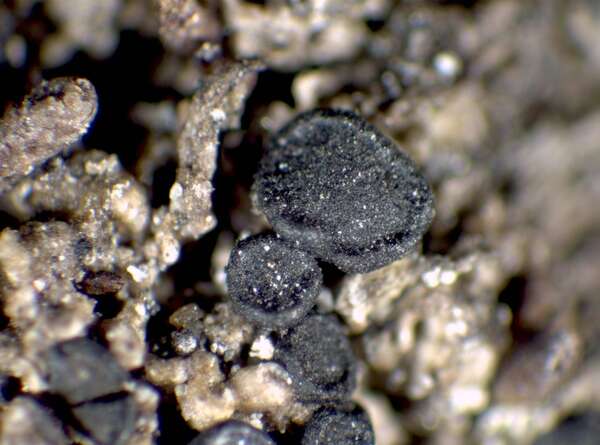Farnoldia muscigena (Vězda) Hafellner & Tretiach
in Tretiach & Hafellner, Herzogia, 14: 106, 2000. Basionym: Lecidea jurana var. muscigena Vězda - Acta Mus. Silesiae, ser. A, 10: 8, 1961.
Synonyms: Melanolecia muscigena (Vězda) Hertel
Distribution: N - Frl (Tretiach & Hafellner 2000), Piem (TSB 32924).
Description: Thallus crustose, whitish grey to brownish, thin, continuous to subareolate. Medulla white, I+ blue. Apothecia lecideine, black, sessile, strongly constricted at base, 0.3-1.2 mm across, with a flat, smooth, epruinose disc, and a thick, raised proper margin. Proper exciple deep black, not transparent in thick sections, of strongly compacted hyphae; epithecium blue-green, K-; hymenium colourless, 85-120 µm high, I+ blue; paraphyses thin, branched and anastomosing, the apical cells slightly thickened; hypothecium black to dark brown, dark green in upper part. Asci 8-spored, clavate, with a I+ pale blue tholus and a central amyloid tube, approaching the Porpidia-type. Ascospores 1-celled, hyaline, ellipsoid, 10-18 x 6-8 µm, halonate at least when young. Pycnidia dark, immersed. Conidia short-bacilliform. Photobiont chlorococcoid. Spot tests: thallus K-, C-, KC-, P-, UV-. Chemistry: without lichen substances.Note: known from the central European mountains (Tatra, Alps) this lichen is found on moribund bryophytes, crustose lichens and plant debris over calcareous substrata above or near treeline; probably more widespread in the Alps.
Growth form: Crustose
Substrata: soil, terricolous mosses, and plant debris
Photobiont: green algae other than Trentepohlia
Reproductive strategy: mainly sexual
Commonnes-rarity: (info)
Alpine belt: very rare
Subalpine belt: very rare
Oromediterranean belt: absent
Montane belt: absent
Submediterranean belt: absent
Padanian area: absent
Humid submediterranean belt: absent
Humid mediterranean belt: absent
Dry mediterranean belt: absent

Predictive model
Herbarium samples
Growth form: Crustose
Substrata: soil, terricolous mosses, and plant debris
Photobiont: green algae other than Trentepohlia
Reproductive strategy: mainly sexual
Commonnes-rarity: (info)
Alpine belt: very rare
Subalpine belt: very rare
Oromediterranean belt: absent
Montane belt: absent
Submediterranean belt: absent
Padanian area: absent
Humid submediterranean belt: absent
Humid mediterranean belt: absent
Dry mediterranean belt: absent

Predictive model
| Herbarium samples |
 INDEX FUNGORUM
INDEX FUNGORUM
 GBIF
GBIF
 DOLICHENS
DOLICHENS




